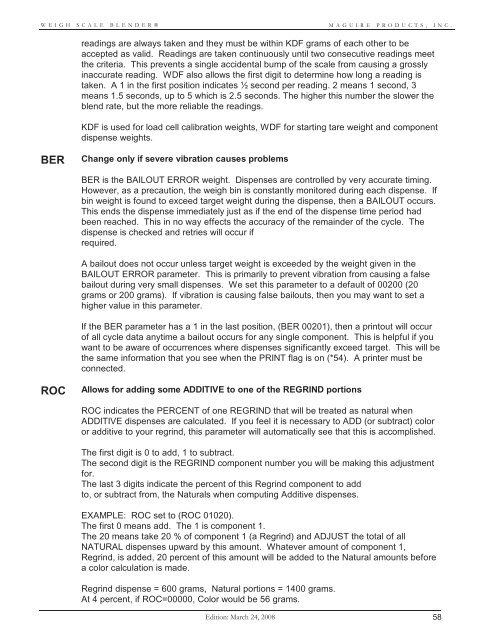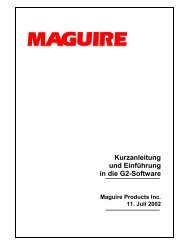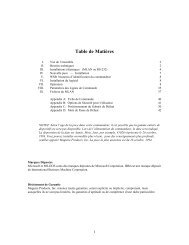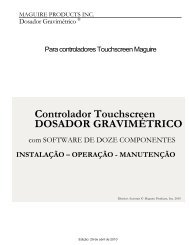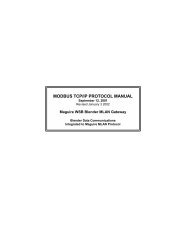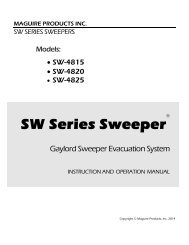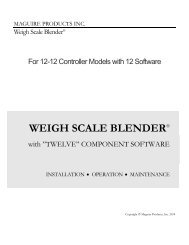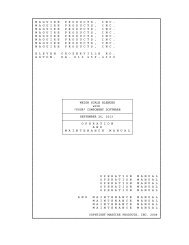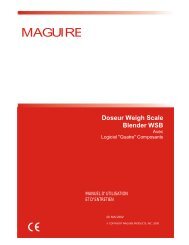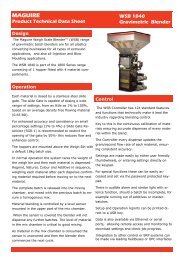WEIGH SCALE BLENDER® - Maguire Products
WEIGH SCALE BLENDER® - Maguire Products
WEIGH SCALE BLENDER® - Maguire Products
Create successful ePaper yourself
Turn your PDF publications into a flip-book with our unique Google optimized e-Paper software.
<strong>WEIGH</strong> <strong>SCALE</strong> <strong>BLENDER®</strong><br />
MAGUIRE PRODUCTS, INC.<br />
readings are always taken and they must be within KDF grams of each other to be<br />
accepted as valid. Readings are taken continuously until two consecutive readings meet<br />
the criteria. This prevents a single accidental bump of the scale from causing a grossly<br />
inaccurate reading. WDF also allows the first digit to determine how long a reading is<br />
taken. A 1 in the first position indicates ½ second per reading. 2 means 1 second, 3<br />
means 1.5 seconds, up to 5 which is 2.5 seconds. The higher this number the slower the<br />
blend rate, but the more reliable the readings.<br />
KDF is used for load cell calibration weights, WDF for starting tare weight and component<br />
dispense weights.<br />
BER<br />
Change only if severe vibration causes problems<br />
BER is the BAILOUT ERROR weight. Dispenses are controlled by very accurate timing.<br />
However, as a precaution, the weigh bin is constantly monitored during each dispense. If<br />
bin weight is found to exceed target weight during the dispense, then a BAILOUT occurs.<br />
This ends the dispense immediately just as if the end of the dispense time period had<br />
been reached. This in no way effects the accuracy of the remainder of the cycle. The<br />
dispense is checked and retries will occur if<br />
required.<br />
A bailout does not occur unless target weight is exceeded by the weight given in the<br />
BAILOUT ERROR parameter. This is primarily to prevent vibration from causing a false<br />
bailout during very small dispenses. We set this parameter to a default of 00200 (20<br />
grams or 200 grams). If vibration is causing false bailouts, then you may want to set a<br />
higher value in this parameter.<br />
If the BER parameter has a 1 in the last position, (BER 00201), then a printout will occur<br />
of all cycle data anytime a bailout occurs for any single component. This is helpful if you<br />
want to be aware of occurrences where dispenses significantly exceed target. This will be<br />
the same information that you see when the PRINT flag is on (*54). A printer must be<br />
connected.<br />
ROC<br />
Allows for adding some ADDITIVE to one of the REGRIND portions<br />
ROC indicates the PERCENT of one REGRIND that will be treated as natural when<br />
ADDITIVE dispenses are calculated. If you feel it is necessary to ADD (or subtract) color<br />
or additive to your regrind, this parameter will automatically see that this is accomplished.<br />
The first digit is 0 to add, 1 to subtract.<br />
The second digit is the REGRIND component number you will be making this adjustment<br />
for.<br />
The last 3 digits indicate the percent of this Regrind component to add<br />
to, or subtract from, the Naturals when computing Additive dispenses.<br />
EXAMPLE: ROC set to (ROC 01020).<br />
The first 0 means add. The 1 is component 1.<br />
The 20 means take 20 % of component 1 (a Regrind) and ADJUST the total of all<br />
NATURAL dispenses upward by this amount. Whatever amount of component 1,<br />
Regrind, is added, 20 percent of this amount will be added to the Natural amounts before<br />
a color calculation is made.<br />
Regrind dispense = 600 grams, Natural portions = 1400 grams.<br />
At 4 percent, if ROC=00000, Color would be 56 grams.<br />
Edition: March 24, 2008 58


